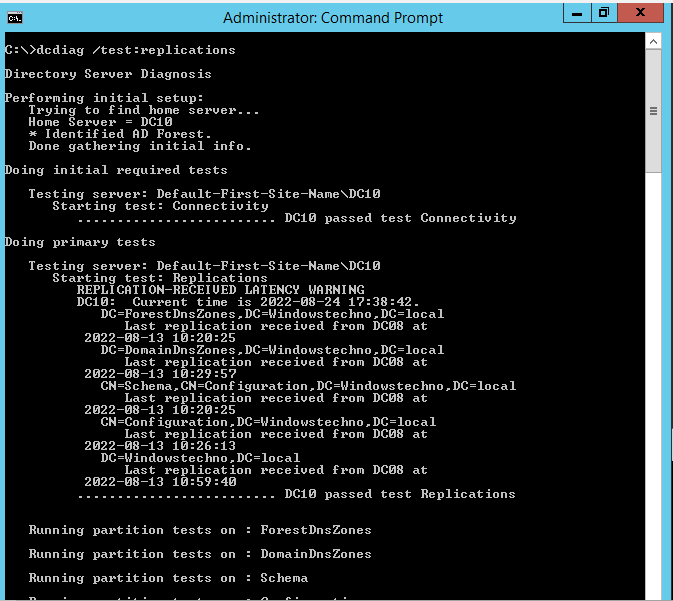DCDIAG /Test:Replications
Hello All,
Hope this post finds you in good health and spirit.
DCDIAG /Test:Replications
This post is regarding Replication checks whether all of the DCs replication partners are able to replicate to it. By default only those in the same site are tested.
Dcdiag is a Microsoft Windows command line utility that can analyze the state of domain controllers in a forest or enterprise. You can choose to analyze a single domain controller or all DC’s in a forest. It is also available if you install the Active Directory Domain Services Tools that are part of the Remote Server Administration Tools (RSAT).
Disabling and Enabling Outbound Replication
The test also contacts all replication partners to get a status update from them. It also checks the replication latency of more than 12 hours.
Run the below command line to do replications checks on domain controller
DCDIAG /Test:Replications

Use repadmin to identify forest-wide Active Directory replication errors
You can create a Microsoft Excel spreadsheet for domain controllers by using the repadmin/showrepl command to view replication errors. To do it, follow these steps:
-
Open a Command Prompt as an administrator:
On the Start menu, right-click Command Prompt, and then click Run as administrator. If the User Account Control dialog box appears, provide Enterprise Admins credentials, and then click Continue.
-
At the command prompt, type the following command, and then press Enter:
repadmin /showrepl * /csv >showrepl.csv -
In Excel, open showrepl.csv.
-
Format the spreadsheet as follows:
- Hide or delete column A and column G.
- Select row 1 underneath the column header row. On the View tab, click Freeze Panes, and then click Freeze Top Row.
- Select the whole spreadsheet. On the Data tab, click Filter.
- In the Last Success Time column, click the down arrow, point to Text Filters, and then click Custom Filter.
- Sort the table from oldest to newest.
- In the Source DC or Source DSA column, click the filter down arrow, point to Text Filters, and then click Custom Filter.
- In the Custom AutoFilter dialog box, under Show rows where, click does not contain. In the adjacent text box, type del to eliminate deleted domain controllers from the view.
- Repeat step 6 for the Last Failure Time column, but use the value does not equal, and then type the value 0.
-
To fix any replication failures that appear under Last Failure Status.
So, that’s all in this blog. I will meet you soon with next stuff .Have a nice day !!!
Recommended contents
How to Check the Active Directory Database Integrity
Disabling and Enabling the Outbound Replication
DFS Replication Service Stopped Replication
What is Strict Replication Consistency
The replication operation failed because of a schema mismatch between the servers involved
Troubleshooting ad replication error 8418 the replication operation failed because of a schema mismatch between the servers
How to export replication information in txt file
Repadmin Replsummary
Enabling the outbound replication
Disabling and enabling replication on schema master domain controller
How to enable strict replication consistency
How to prevent lingering objects replication in active directory
AD replication process overview
How to force active directory replication
Change notification in replication process
How to check replication partner for a specific domain controller
dcdiag test replications
Guys please don’t forget to like and share the post.Also join our WindowsTechno Community and where you can post your queries/doubts and our experts will address them .
You can also share the feedback on below windows techno email id.
If you have any questions feel free to contact us on admin@windowstechno.com also follow us on facebook@windowstechno to get updates about new blog posts.
